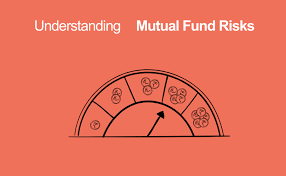
Investing in mutual funds offers an opportunity to grow wealth through diversification, professional management, and access to various asset classes. However, like any investment, mutual funds come with inherent risks. Effective risk management is key to safeguarding your portfolio and achieving long-term financial goals. In this article, we will explore how mutual fund risk works, the different types of risks involved, and strategies to protect your investments.
Understanding Mutual Fund Risk
Mutual funds pool money from multiple investors and invest in a diverse range of assets, such as stocks, bonds, and other securities. While this offers diversification, it does not eliminate risk entirely. Risk in mutual funds can stem from various factors, including market volatility, economic conditions, and interest rate changes. Understanding these risks and how they affect your investments is crucial for making informed decisions.
Types of Risks in Mutual Funds
- Market Risk
- Description: Market risk refers to the potential for an investment to lose value due to overall market fluctuations. For mutual funds, this risk arises from changes in the stock or bond market.
- Example: A downturn in the stock market could negatively impact the value of equity mutual funds.
- Interest Rate Risk
- Description: This risk affects bond funds. When interest rates rise, the value of existing bonds tends to fall, which can cause a decline in bond fund values.
- Example: If you invest in a bond mutual fund and interest rates increase, the price of the bonds within the fund may decrease, affecting the fund’s performance.
- Credit Risk
- Description: Credit risk occurs when the issuer of a bond or debt security within the mutual fund fails to meet its obligations. This risk is more relevant in bond mutual funds that invest in corporate or lower-rated bonds.
- Example: A company defaults on a bond payment, reducing the overall value of the bond mutual fund.
- Liquidity Risk
- Description: Liquidity risk refers to the possibility that you may not be able to buy or sell mutual fund shares easily at the desired price due to low market activity or other factors.
- Example: A mutual fund invested in small-cap stocks or niche sectors may have difficulty finding buyers or sellers, making it harder to liquidate your investment quickly.
- Currency Risk
- Description: Currency risk is relevant for mutual funds that invest in foreign securities. Exchange rate fluctuations between different currencies can lead to losses or gains.
- Example:A mutual fund that holds international stocks may lose value if the U.S. dollar strengthens relative to the currency of the country where the stock is based. This currency risk is something a mutual fund distributor will often highlight when recommending funds that invest in foreign assets, as fluctuations in exchange rates can impact the returns of international investments.
Strategies for Managing Risk in Mutual Funds
- Diversification
- What It Is: Diversification is the practice of spreading investments across various asset classes, sectors, and geographical regions to reduce the impact of any one investment’s poor performance.
- Why It Helps: Diversification helps mitigate specific risks such as sector downturns by ensuring that the overall fund performance isn’t tied to one single investment. A diversified mutual fund typically holds stocks, bonds, and possibly other assets like real estate or commodities. Additionally, using a Commodity Trading App can help investors further diversify by gaining exposure to commodities like gold, silver, and crude oil, which can act as a hedge against market volatility.
- Example: A balanced fund that invests in both equities and fixed-income securities provides a buffer during periods of stock market volatility.
- Asset Allocation
- What It Is: Asset allocation is the process of determining how to distribute your investment across different types of assets (stocks, bonds, cash, etc.) based on your financial goals, risk tolerance, and time horizon.
- Why It Helps: Different asset classes react differently to economic and market conditions. For example, stocks tend to perform well during periods of growth, while bonds may do better during times of economic uncertainty.
- How to Implement: If you have a low risk tolerance, you may allocate a larger portion of your portfolio to bond funds or stable-value funds. On the other hand, if you’re looking for higher returns and are willing to accept more risk, you may focus more on equity mutual funds.
- Choosing the Right Fund
- What It Is: Selecting a mutual fund that aligns with your risk tolerance and investment goals is crucial for managing risk. Funds vary in terms of their objectives, strategies, and risk profiles.
- How to Evaluate: Research the fund’s historical performance, manager track record, and the underlying securities within the fund. Make sure it aligns with your long-term financial goals.
- Example: If you’re nearing retirement and want to minimize risk, a conservative bond fund may be a better choice than an aggressive growth stock fund.
- Dollar-Cost Averaging (DCA)
- What It Is: Dollar-cost averaging is an investment strategy where you invest a fixed amount of money in a mutual fund at regular intervals, regardless of the market’s performance.
- Why It Helps: This strategy helps reduce the impact of market volatility, as it prevents you from investing a lump sum during a market high. Over time, this lowers the average cost of your investment and reduces the risk of entering the market at an unfavorable time.
- Example: If you invest $500 in a mutual fund every month, you buy more shares when the price is low and fewer shares when the price is high, which averages out the cost over time.
- Rebalancing Your Portfolio
- What It Is: Rebalancing involves periodically adjusting your portfolio to maintain your desired asset allocation. As some investments outperform others, the original balance may shift, increasing exposure to one asset class.
- Why It Helps: Rebalancing ensures that your portfolio stays aligned with your risk tolerance and investment objectives. For example, if your equity funds perform well and become a larger portion of your portfolio, you might sell some stocks and buy more bonds to bring the balance back.
- How Often to Rebalance: Rebalancing is typically done annually or semi-annually, but it can also be done when major market movements cause significant changes in your asset allocation.
Conclusion
While mutual funds are a powerful investment tool offering diversification and professional management, they are not risk-free. Understanding the various risks involved, such as market, interest rate, and credit risks, is the first step in protecting your investments. By employing strategies such as diversification, asset allocation, dollar-cost averaging, and regular rebalancing, you can effectively manage risk and work toward achieving your financial goals. Whether you’re a new investor or a seasoned one, these risk management practices can help ensure your mutual fund investments remain aligned with your objectives and risk tolerance.
Stay in touch to get more news & updates on Buzz Feed!






